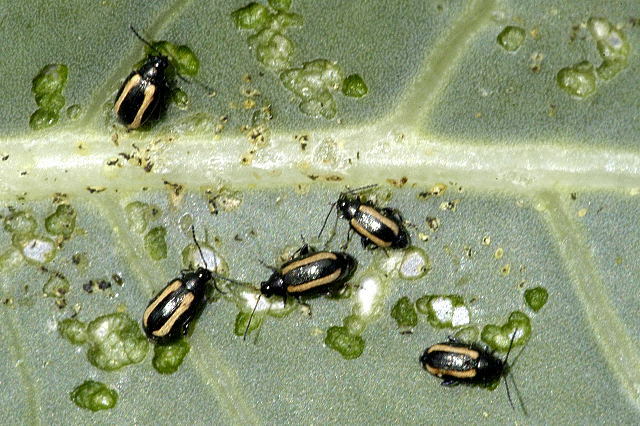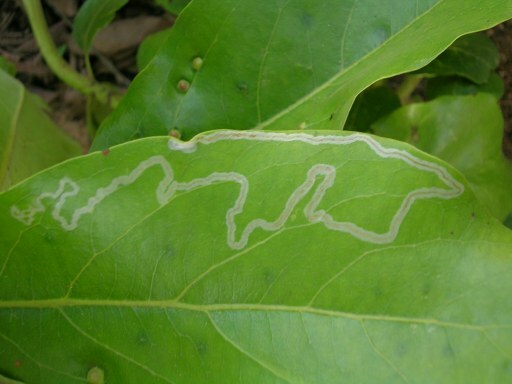Endive
Description
Uses
Propagation
References
Common Pests and Diseases
Diseases
Category : Fungal
Anthracnose Microdochium panttonianum
Symptoms
Small circular or irregularly shaped dry spots which are gray to straw in color on leaves; a high number of spots may cause the leaf to die; lesions may coalesce to form large necrotic patches causing leaves to turn yellow and wilt; lesions may split or crack in dry centers
Cause
Fungus
Comments
Fungus overwinters on leaf debris and on related weeds; disease emergence is favored by moist, warm conditions
Management
Control of disease depends on sanitary practices; treat seeds with hot water prior to planting; rotate crops; plant in an area with good soil drainage; remove all cruciferous weeds which may act as a reservoir for the fungusBottom rot Rhizoctonia solani
Symptoms
Small red to brown spots on lower leaves, usually on underside of midrib which may expand rapidly causing the leaves to rot; amber colored liquid may ooze from leaf lesions; as stems rot, head of lettuce becomes slimy and brown and collapse; a tan or brown mycelial growth may be visible in infected tissue
Cause
Fungus
Comments
Fungus survives on crop debris in soil; disease emergence favored by warm, wet weather
Management
Disease is most effectively managed by combining cultural control with fungicide application; plow soil before planting; rotate crops regularly; avoid irrigation close to harvest; plant varieties with an erect growth habit to reduce leaf contact with soil; apply appropriate foliar fungicides
Damping-off
Pythium spp.
Rhizoctonia solani
Symptoms
Poor seedling germination and emergence; dark lesions on stems; withered stem; stems collapsing; brown rotting roots
Cause
Fungi
Comments
Disease emergence in seedlings favored by cool temperatures
Management
Plant pathogen-free seed or transplants that have been produced in sterilized soil; apply fungicide to seed to kill off any fungi; shallow plant seeds or delay planting until soil warmsDowny mildew Bremia lactucae
Symptoms
Young leaves drying up and dropping off; older leaves developing a papery texture; white fuzzy mold on the underside of leaves
Cause
Fungus
Comments
Disease favors cool, moist conditions; can be spread via infected seed; fungus survives in plant debris and in wild lettuce plants
Management
Disease is controlled primarily by planting resistant varieties and/or by applying appropriate fungicidesSclerotinia blight (Sclerotinia drop) Sclerotinia sclerotiorum
Symptoms
Wilting of outside leaves which spreads inwards until whole plant is affected; soft watery lesions on leaves; leaves collapse and lie on soil surface; black fungal structures on infected leaf tissue and soil surface
Cause
Fungus
Comments
Fungi can survive in soil for 8-10 years
Management
Rotate crop to non-hosts (e.g. cereals) for at least 3 years; control weeds; avoid dense growth by planting in adequately spaced rows; disease significantly reduced by application of fungicides immediately after thinning plants; plow soil deeplySeptoria blight Septoria lactucae
Symptoms
Small, irregularly shaped chlorotic spots on oldest plant leaves which enlarge and turn brown and dry out; lesiuons may fall out of leaves creating holes; leaf spots may have chlorotic halos; if plant is severely infected, lesions may coalesce forming large necrotic patches, wilting leaves and plant death
Cause
Fungus
Comments
Fungus survives in infected seed and in crop debris; disease spreads in humid or wet conditions; can be spread by splashing water; wild lettuce is an important overwintering site for the fungus
Management
Plant pathogen free seed; plant in areas where Septoria is uncommon; ideal planting sites are in regions with low rainfall; hot water treatment of seeds prior to planting may help reduce levels of diseaseCategory : Bacterial
Bacteral soft rot Erwinia spp.
Symptoms
Water-soaked lesions which expand to form a large rotted mass of cream colored tissue which is liquid underneath; surface of lesions usually crack and exude slimy liquid which turns tan, dark brown or black on exposure to air
Cause
Bacteria
Comments
Bacteria are easily spread on tools and by irrigation water; disease emergence favored by warm, moist conditions; bacteria enter plant through wounds
Management
Chemical treatments are not available for bacterial soft rot, control relies on cultural practices; rotate crops; plant cabbage in well-draining soils or raised beds; only harvest heads when they are dry; avoid damaging heads during harvestCategory : Other
Slugs & snails (Gray garden slug, Spotted garden slug, Brown garden snail, European garden snail , etc.)
Decoratus reticulatum
Limax maximus
Helix aspersa
Cornu aspersum
Symptoms
Irregularly shaped holes in leaves and stems; flowers and fruit may also be damaged if present; if infestation is severe, leaves may be shredded; slime trails present on rocks, walkways, soil and plant foliage; several slug and snail species are common garden pests; slugs are dark gray to black in color and can range in size from 2.5 to 10 cm (1-4 in); garden snails are generally smaller and possess a rounded or spiral shell
Cause
Mollusc
Comments
Slugs and snails prefer moist, shaded habitats and will shelter in weeds or organic trash; adults may deposit eggs in the soil throughout the season; damage to plants can be extensive
Management
Practice good garden sanitation by removing garden trash, weeds and plant debris to promote good air circulation and reduce moist habitat for slugs and snails; handpick slugs at night to decrease population; spread wood ashes or eggshells around plants; attract molluscs by leaving out organic matter such as lettuce or grapefruit skins, destroy any found feeding on lure; sink shallow dishes filled with beer into the soil to attract and drown the molluscs; chemical controls include ferrous phosphate for organic gardens and metaldehyde (e.g. Buggeta) and carbaryl (e.g Sevin bait) for non-organic growersPests
Category : Insects
Aphids (Green peach aphid, Lettuce aphid, Plum aphid)
Myzus perisicae
Nasonovia ribisnigri
Brachycaudus helichrysi
Symptoms
Small soft bodied insects on underside of leaves and/or stems of plant; usually green or yellow in color, but may be pink, brown, red or black depending on species and host plant; if aphid infestation is heavy it may cause leaves to yellow and/or distorted, necrotic spots on leaves and/or stunted shoots; aphids secrete a sticky, sugary substance called honeydew which encourages the growth of sooty mold on the plants
Cause
Insect
Comments
Aphids will be visible on the leaves; small, rounded green to pink insects; distinguishing features include the presence of cornicles (tubular structures) which project backwards from the body of the aphid; will generally not move very quickly when disturbed
Management
If aphid population is limited to just a few leaves or shoots then the infestation can be pruned out to provide control; check transplants for aphids before planting; use tolerant varieties if available; reflective mulches such as silver colored plastic can deter aphids from feeding on plants; sturdy plants can be sprayed with a strong jet of water to knock aphids from leaves; insecticides are generally only required to treat aphids if the infestation is very high - plants generally tolerate low and medium level infestation; insecticidal soaps or oils such as neem or canola oil are usually the best method of control; always check the labels of the products for specific usage guidelines prior to use
Darkling beetles
Eleodes sp
Blapstinus spp.
Caelus spp.
Symptoms
Feeding damage on stems; death of seedlings; seeds dug up; insect is a dull blue-black or brown beetle about 0.6 cm (0.52 in) long; tips of antennae are often enlarged, resembling a club
Cause
Insect
Comments
Beetles are generally active at night; during the day beetles hide in organic debris
Management
Ditches filled with water can prevent spread of beetle to/from adjacent fields; remove all weeds from garden borders; if beetle is problematic then appropriate insecticides can provide control; insecticides are usually in the form of baits
Flea beetles
Epitrix spp.
Phyllotreta spp.
Symptoms
Small holes or pits in leaves that give the foliage a characteristic “shothole” appearance; young plants and seedlings are particularly susceptible; plant growth may be reduced; if damage is severe the plant may be killed; the pest responsible for the damage is a small (1.5–3.0 mm) dark colored beetle which jumps when disturbed; the beetles are often shiny in appearance
Cause
Insect
Comments
Younger plants are more susceptible to flea beetle damage than older ones; older plants can tolerate infestation; flea beetles may overwinter on nearby weed species, in plant debris or in the soil; insects may go through a second or third generation in one year
Management
In areas where flea beetles are a problem, floating row covers may have to be used prior to the emergence of the beetles to provide a physical barrier to protect young plants; plant seeds early to allow establishment before the beetles become a problem - mature plants are less susceptible to damage; trap crops may provide a measure of control - cruciferous plants are best; application of a thick layer of mulch may help prevent beetles reaching surface; application on diamotecoeus earth or oils such as neem oil are effective control methods for organic growers; application of insecticides containing carbaryl, spinosad, bifenthrin and permethrin can provide adequate control of beetles for up to a week but will need reappliedLeafminers Liriomyza spp
Symptoms
Thin, white, winding trails on leaves; heavy mining can result in white blotches on leaves and leaves dropping from the plant prematurely; early infestation can cause fruit yield to be reduced; adult leafminer is a small black and yellow fly which lays its eggs in the leaf; larave hatch and feed on leaf interior
Cause
Insect
Comments
Mature larvae drop from leaves into soil to pupate; entire lifecycle can take as little as 2 weeks in warm weather; insect may go through 7 to 10 generations per year
Management
Check transplants for signs of leafminer damage prior to planting; remove plants from soil immediately after harvest; only use insecticides when leafminer damage has been identified as unnecessary spraying will also reduce populations of their natural enemies
Loopers (Cabbage looper, Alfalfa looper)
Trichoplusia ni
Autographa californica
Symptoms
Large or small holes in leaves; damage often extensive; caterpillars are pale green with a white lines running down either side of their body; caterpillars are easily distinguished by the way they arch their body when moving; eggs are laid singly, usually on the lower leaf surface close to the leaf margin, and are white or pale green in color
Cause
Insect
Comments
Insects overwinter as pupae in crop debris in soil; adult insect id a dark colored moth; caterpillars have a wide host range
Management
Looper populations are usually held in check by natural enemies; if they do become problematic larvae can be hand-picked from the plants; an organically acceptable control method is the application of Bacillus thuringiensis which effectively kills younger larvae; chemical sprays may damage populations of natural enemies and should and should be selected carefully
Thrips (Western flower thrips, Onion thrips)
Frankliniella occidentalis
Thrips tabaci
Symptoms
If population is high leaves may be distorted; leaves are covered in coarse stippling and may appear silvery; leaves speckled with black feces; insect is small (1.5 mm) and slender and best viewed using a hand lens; adult thrips are pale yellow to light brown and the nymphs are smaller and lighter in color
Cause
Insect
Comments
Transmit viruses such as Tomato spotted wilt virus; once acquired, the insect retains the ability to transmit the virus for the remainder of its life









